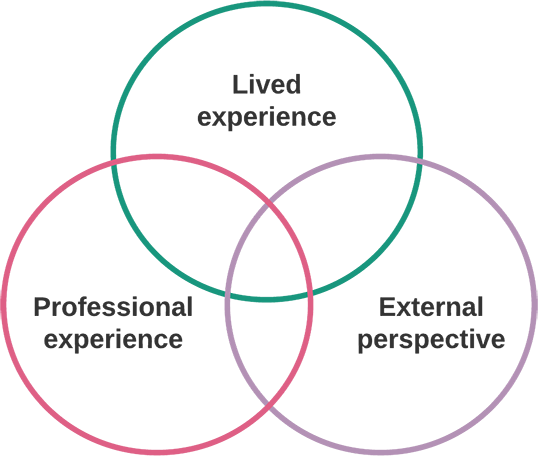Involving the right people
Who needs to be involved?

- Lived experience – Consumers and clients (past, current, future), community members
- Professional experience – Front line clinicians, managers, researchers. Having a manager or someone responsible for ultimately funding or providing organisational support on your team is key.
- External perspective – Designers, people who bring curiosity and buffer the power differential
Your co-design team will ideally have equal representation from each of these groups. Your team should be diverse and reflect the target group you are co-designing for; consider diversity across your team in sex and gender, cultural and ethnic background, ability/disability, age, LGBTQIA+. Note: these boundaries are often less clear cut in reality, with individuals often identifying with several groups.
Having someone who brings external perspective is key to allow someone who sits outside of the power differential between lived and professional experience. They should be charged with the role of gently challenging assumptions and expose gaps in what people say, do and believe.
Design expertise is key to co-design (the clue is in the name: co-design). Many of our university partners have design schools. For example, QUT has a Design Lab and offers design internships which may be an opportunity for a designer to come work on your team. Queensland Health’s Clinical Excellence Queensland also has links with designers that might be useful for your project.
Who should lead your co-design team?
We recommend a co-lead model, where the team is led by a person with lived experience and a person with professional experience working together in partnership.
This model has the benefits of re-balancing power, by elevating lived experience to this leadership role. It is important to ensure that you have the right people leading this process, see The Right Facilitator.
How do I know that I have the right people in the co-design team?
Successful co-design team members are:
- Willing to listen, share and learn
- Respectful of lived experience, and the experience of others
- Focused on increasing dignity and choice
- Able listen without fact checking/looking to validate someone’s experience
- Diverse in their perspectives and identity
- Sensitive to inequities
- Self-aware and have interpersonal flexibility
- Willing to be uncomfortable
- Frustrated with the status quo
- Able to represent their experience, not others’
- Interested in being part of a team, sharing their thoughts and learning
- Committed to curiosity and compassion
- Open to ideas and don’t come with a solution in mind
- Able to challenge professionals (even those who have lots of power)*
- Are critical and creative thinkers*
- Can expose the gaps in what people say, do and believe*
*these attributes are usually brought by people with external perspectives
Adapted from McKercher, K. A. (2020). Beyond Sticky Notes

